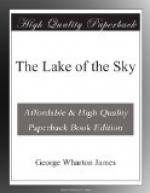CHAPTER XXXII
HOW TO DISTINGUISH THE TREES OF THE TAHOE REGION
By “trees” in this chapter I mean only the evergreen trees—the pines, firs, spruces, hemlocks, cedars, junipers and tamaracks. Many visitors like to know at least enough when they are looking at a tree, to tell which of the above species it belongs to. All I aim to do here is to seek to make clear the distinguishing features of the various trees, and to give some of the more readily discernible signs of the different varieties of the same species found in the region.
It must not be forgotten that tree growth is largely dependent upon soil conditions. The soil of the Tahoe region is chiefly glacial detritus.
On the slopes and summits of the ridges it is sandy, gravelly, and liberally strewn with masses of drift bowlders. The flats largely formed of silting while they still constituted beds of lakes, have a deep soil of fine sand and mold resting on coarse gravel and bowlder drift. Ridges composed of brecciated lavas, which crumble easily under the influence of atmospheric agencies, are covered with soil two or three feet, or even more, in depth, where gentle slopes or broad saddles have favored deposition and prevented washing. The granite areas of the main range and elsewhere have a very thin soil. The flats at the entrance of small streams into Lake Tahoe are covered with deep soil, owing to deposition of vegetable matter brought from the slopes adjacent to their channels. As a whole, the soil of the region is of sufficient fertility to support a heavy forest growth, its depth depends wholly on local circumstances favoring washing and removal of the soil elements as fast as formed, or holding them in place and compelling accumulations.[1]
Coniferous species of trees constitute fully ninety-five per cent. of the arborescent growth in the region. The remaining five per cent. consists mostly of different species of oak, ash, maple, mountain-mahogany, aspen, cottonwood, California buckeye, western red-bud, arborescent willows, alders, etc.
Of the conifers the species are as follows: yellow pine, pinus ponderosa; Jeffrey pine, pinus jeffreyi; sugar pine, pinus lambertiana; lodge-pole pine, pinus murrayana; white pine, pinus monticola; digger pine, pinus sabiniana; white-bark pine, pinus albicaulis; red fir, pseudotsuga taxifolia; white fir, abies concolor; Shasta fir, abies magnifica; patton hemlock or alpine spruce, tsuga pattoniana; incense cedar, libocedrus decurrens; western juniper, juniperus occidentalis; yew, taxus brevifolia.
[Footnote 1: John B. Leiberg, in Forest Conditions in the Northern Sierra Nevada.]
The range and chief characteristic of these trees, generally speaking, are as follows:




